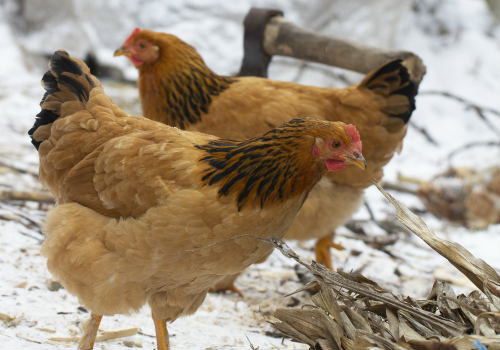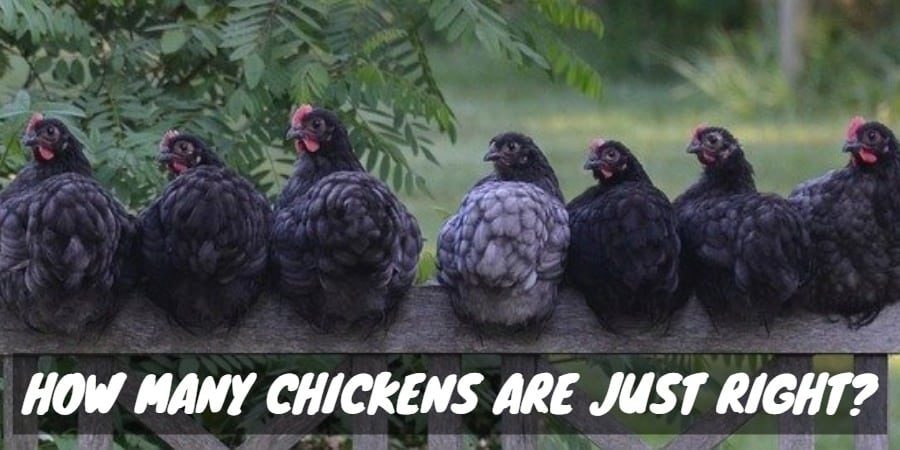Winter is one of the most important times for chicken owners. So how low can the thermometer drop before it becomes a problem for your feathered friends? This is an area that presents a lot of problems for those who are new to raising chickens. I’ve seen this same question radiate across forums and it’s usually answered with a vague response. This article is going to dive much deeper into this important topic. You will know the exact steps to take to tuck away those chickens even during the harshest of winters.
How Low Can They Go?
Chickens are able to cope quite well with extremely low temperatures. In fact, the input needed from us is minimal as long as the temperature does not drop below 20 degrees. In short, chickens are great at dealing with cold weather. Heat actually causes more problems with chickens than the cold weather.
Feathers insulate chickens so that their body heat is trapped against them. Our feathered friends also tuck their head under their wing when sleeping. This is to retain even more body heat.
There are a few issues that you will need to be on the lookout for. If you have a large cone breed of chicken, then they could suffer from frostbite. This is only an issue during certain weather so you might need to take extra precautions with these breeds. Consider closing off a small section of your coop for these birds at night. This allows their body heat to keep the section warm enough for these birds to avoid having their cones damaged from frostbite.

Chickens also have an exceptionally high metabolism so they are able to raise their heart rates to stay warm. They can reach up to 400 beats per minute!
As long as the temperature does not drop down into the teens, then your birds are going to be able to deal with winter. That’s why people in extremely cold climates are able to keep chickens all year without adding any artificial heat.
But I know that you are looking for ways to ensure that your chickens not only
Prepare Your Chickens to Thrive During Winter
A few extra steps can help your chickens thrive during winter. By thriving, I mean that your hens will not only remain healthy during the coldest of months, but they will also keep laying eggs.
Winter preparation starts during the early fall months. As you might expect, some breeds are going to have a much harder time adapting to the cold than others. Luckily, the process for preparing them is the same.
Hens will stop laying eggs during winter due to the days being shorter so if we want our hens to keep laying, we are going to have to provide artificial light. Once your birds have gone through molting, install some artificial lights inside of the coop. Hens need 10 hours of light per day to stimulate the egg-laying process. Place your lights on a timer so they will kick on during the evening to add the right amount of lighting to the coop. Be careful not to overstimulate them. For example, if your birds get 8 hours of sunlight per day, then set the timer to keep the artificial lights on for 2 hours in the evening.
[amazon bestseller=”Portable Solar Lights for chicken coop”]
The intensity of lighting is also an important factor. Rule of thumb states that a 40-watt bulb will provide enough light for up to 200 square feet.
Make Sure Your Chickens Are Getting Enough Feed

Chickens will eat more during winter to fuel their boosted metabolism. Make sure you are giving them enough feed. Here are some of the signs that you need to keep an eye on:
- If there is feed leftover when your chickens start roosting, then you are feeding them too much. Try reducing this amount gradually until their feeders are empty.
- If you see your chickens scratching around for food during the day and their feeders are empty, then you are not feeding them enough. Try gradually increasing the amount until they are running out before roost.
I recommend that you toss out chicken scratch because it will keep the bird’s digestive system working all night. This keeps their metabolic rate high, thus keeping them warm.
Watering Chickens During Winter Is Tricky
Unless you can afford to spend money on heated drinkers, you will have to rely on visual inspections of your birds’ water supply. Take at least three trips to the coop every day to make sure that the water is not starting to freeze.
Installing plastic bowls is going to make your life easier. Ice takes longer to form in plastic than it will in traditional metal watering systems.
[amazon bestseller=”chicken water”]
Ensure That the Coop Is Well-Ventilated
With temperatures plummeting, it can be quite tempting to insulate the coop to the point where it’s going to limit air circulation. This will lead to humidity that makes your chickens sick so our goal is to insulate the coop in a way that still allows fresh air to circulate. I cannot over-emphasize the importance of proper ventilation.
The best method of ventilating a chicken coop is to build some small screen windows where the walls meet the roof. You can even install these windows in a way where you can close them during the coldest hours.
After installing these windows, you need to make absolutely sure that the coop is still waterproof. Your birds cannot fight off cold and wet conditions at the same time. They will get sick, catch diseases, and likely die.
Another advantage of installing windows is that they will draw sunlight into the coop during the day. That sunlight is then trapped by the insulation, keeping the coop warm for longer once the sun sets.
You can add to this effect by adding materials inside of the coop that will absorb heat. That heat is released slowly during nightfall. Materials that tend to absorb the most heat include compost, straw, and stones.
Consider Artificial Heat Lamps for the Coldest Days
If the temperature is going to drop down in the teens, then adding heat lamps is a way to ensure that your birds thrive. You just need enough heat to get the temperature slightly above freezing. Your goal here is to prevent frostbite.
Note: Be sure that you do not provide too much heat because it will prevent chickens from being able to cope with cold temperatures on their own.
An alternative to heat lamps is to use an oil filled radiator to heat the coop. Oil radiators do not pose the same fire risk as heat lamps.
[amazon bestseller=”oil filled radiator”]
You can also add straw to the floor to provide further insulation. It will also protect their feet from frostbite. There is a more advanced option for flooring called the “Deep Litter Method.” This method requires the use of an organic matter like wood shavings to layer the floor in a way that provides extra insulation. It will add more heat-absorption materials to the coop that hold in the heat from sunlight.
Protect Their Wattles and Combs
Chicken breeds that have large wattles and cones need special care in the
- Use petroleum jelly to coat the wattle and cone. Rub it into the red skin that is showing around the chicken’s head.
- When applying the jelly to your birds, take the time to closely observe them. If the wattle is black, then they are already suffering from frostbite. Be careful when applying jelly to this area.
- You need to inspect the birds every day leading up to severely cold nights. If their skin is still oily, then you do not need to apply more jelly.
Let Your Chicken Go Outside

If at all possible, let your chickens go outside when it’s cold. You can attach a run to your coop and open it up during the day. Many people believe that chickens will hate the cold weather so they keep them cooped up inside but why not give them the choice? When you open up the run, most of your chickens are going to love the opportunity to get some fresh air.
The only times when you should not allow chickens outside is when it’s snowing, windy, or rainy.
The Bottom Line
It has to be extremely cold weather to become dangerous for chickens because they have an uncanny ability to adapt to low temperatures. Our goal is to make sure our chickens thrive during the winter.
I feel that I need to drive home one important fact before we wrap things up. Ventilation is an essential factor to keep in mind. This is an area where beginners can really drop the ball, therefore, make sure that your coop is properly ventilated.
Start winterizing your coop before the weather gets cold and ensure that your chickens are healthy and productive.





chickens so swag!